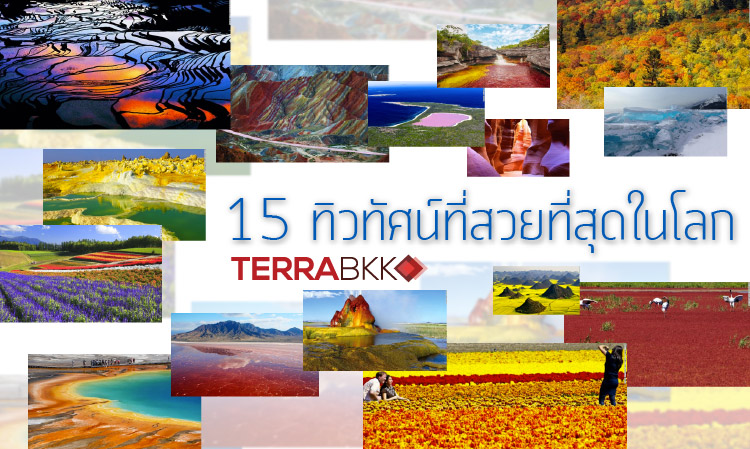15 of the world's most colorful landscapes
Mother Nature is not afraid to go technicolor for the right effect. These eye-catching landscapes are among the world's most vivid. Some are completely natural, while others have been helped along by humans. It's no easy feat to reach many of these spots, but they're all worth a closer look.
Dallol, EthiopiaThe Dallol hydrothermal field is northeast of the Erta Ale Range in one of the lowest and hottest areas of the desolate Danakil Depression in Ethiopia. The Dallol craters are the Earth's lowest known subaerial volcanic vents. Salty hot springs featuring a rich palette of colors dot the area. There are hot yellow sulphur fields among the white salt beds.

Bubblegum-pink Lake Hillier is a nearly 2,000-foot-wide lake on Middle Island, the largest of the Recherche island chain in the state of Western Australia. The remote lake is accessible via plane or boat excursion from nearby Esperance. The cause of the Lake Hillier's color isn't fully known. A high level of salinity and dye-producing bacteria are possible sources of the distinctive hue.

Called "The Liquid Rainbow" and "The River of Five Colors," Colombia's Caño Cristales River puts on a splashy show each year between July and November. An eruption of colorful algae brings a predominantly blood red color to the river when the water levels are right. Guides offer tours of the area, which is part of the national park Sierra de La Macarena in the department of Meta.

Beautifully striped rock formations define the Danxia Landform near Zhangye in China's Gansu province. The rich, earthy, colors are the result of sandstone and minerals deposited millions of years ago.

The mirrorlike pools of Yuanyang County's flooded rice terraces in China's Yunnan province allow for an array of intense visual effects. Ancestors of the Hani people crafted the terraces by hand more than 1,000 years ago to irrigate the red rice crop. The terraces change with the seasons; in the winter and spring, flooded paddies create reflective pools, which give way to rippling ribbons of bold green in the summer growing season.

The largest hot spring in Yellowstone, Grand Prismatic Spring is about 300 feet (90 meters) across and 165 feet (50 meters) deep. At 188 degrees Fahrenheit, the bright blue water at the center of the pool is too hot to support life, but bacteria and algae thrive along the edges. The heat-loving bacteria produce orange, yellow and red pigments as a natural sunscreen, creating the spring's psychedelic look.

Neon-yellow canola flowers blanket China's Luoping Basin in March. Each spring a festival celebrates the bright sea of golden flowers.

Blooming flowers bring swaths of color to Hokkaido, the least developed of Japan's four main islands. The island's summers are usually sunny and clear, attracting tourists looking to camp and hike in the wide-open spaces. Lavender and tulips are among the flowers cultivated on the hills from spring to fall.

This caustic lake along the Great Rift Valley in Tanzania is extremely salty, hot and inhospitable to most plants and animals. However, flamingos and other wetland birds thrive here alongside a species of alkaline tilapia and the salt-loving microorganisms that give the water an otherworldly red hue.

Some landscapes spring to life with light. The oranges, pinks and purples of Antelope Canyon near Page, Arizona, are amplified and muted by the changing sunlight filtering down from above, with the most intense colors emerging during the summer months. Antelope Canyon is the Southwest's most photographed slot canyon, formed by water slicing through a mesa. The sandstone canyon is on Navajo land, and guided tours are available.

With a maximum depth of about 5,250 feet (more than 1,600 meters), Lake Baikal in Siberia is the world's deepest lake. It also contains nearly 20% of the globe's unfrozen freshwater reserve. The lake produces a mesmerizing clear turquoise ice when it does freeze.

In the Liaohe River delta outside Panjin, China, in Liaoning province, Red Beach gets its name from seaweed that flourishes in the saline-alkali soil. The plant turns a vibrant red in the fall.

Visitors flock to the Netherlands each spring to wade in knee-deep fields of tulips. From mid-March to the end of May, saturated fields of flowers dot the landscape. Mid-April is considered the peak of the flowering season.

Deciduous trees in the Northeastern United States create a tapestry of rich colors in the fall. While familiar to U.S. travelers, the colorful leaves never fail to draw hordes of autumn "leaf peepers.

This colorful curiosity on private property in the Black Rock Desert in Washoe County, Nevada, is largely unknown because it's not open to the public. But the owners do offer occasional tours, and it's visible from the road. Evidently a man-made accident, this odd formation grew and evolved after a hole drilled in the earth began to spew geothermally heated water. The resulting buildup is this fantastic fountain.















